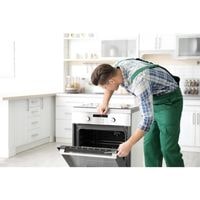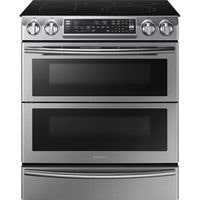Samsung Oven Won’t Turn On. You need to get your oven working again so you can bake some pastries. Switch the circuit breaker back on first to see if your power source is working.
You can try connecting the oven to another power outlet and see if it works with another power source.
In case neither of the above solutions worked, you should check the heating elements or gas. You definitely need a specialist for this kind of problem since these appliances are more tricky than most others but even.
We would still recommend going through a technician at least initially just so they can fully diagnose the problem before deciding whether or not to repair it themselves as this could be one of those instances where a seemingly small problem ends up being more significant later on and may even end up costing you more money in the long run.
Samsung Oven Won’t Turn On

We discuss some problems with Samsung ovens that won’t turn on here.
Problems With Relay Boards
Some ovens may have a relay board. The board has several relays which control the power to the heating element.
If one or more of the relays on the boards fail, the oven won’t heat up but this rarely occurs.
Before replacing the relay board, try checking all of your heating components in your oven because it might be them and not necessarily your circuitry and if none of those heating elements are at fault then replace the faulty relay board instead.
Fault In The Oven Control Board
The oven control board has relays that send voltage to the bake and broil circuits according to the user settings and sensor input. If the control board is defective, it may not send voltage to the heating components.
However, this is rarely the case. Before replacing the control board in your gas range, first test all of the heating components.
If you determine that all of them are working properly, replacing the control board as a faulty one could possibly create problems for you later on down the road by not sending voltage to other components.
Replacing one component at a time greatly reduces your chances of having to do any further repairs which will save money and take less time.
Thermal Fuse Failure
If the thermal fuse has been tripped, your oven will not turn on. Check to make sure the thermal fuse is not blown.
If it is no longer working and you wish to replace it, use a multimeter to check for continuity in the fuse by placing one probe of your multimeter on each lead of the thermal fuse.
If there is no continuity between any of the left lead, right lead, or common lead, purchase a replacement. Fuses cannot be reset you must replace them if they have blown!
Malfunction Of The Broiler Element
When the broil element is heating properly, it glows red hot. If the element does not glow red, this indicates that the element is not heating. Often if the broil element has burned out, it will be damaged and appear as such.
Inspect the broil element for holes or blisters to check whether or not it was just damaged as well as use a multimeter to test for continuity.
If the broil element does not have continuity after replacing it, you might need to replace your oven’s thermostat.
Error In Igniter
The igniter system is the most common deficient part when it comes to gas ovens. The igniter helps you not only ignite your oven but also ensures that your safety systems are up to par.
For example, the igniter helps open a safety valve which then allows gas to flow into the burner assembly.
If the igniter gets weak, it will not be able to perform its duty in an efficient manner or perhaps not at all.
If this happens, your oven will not light up, and you must inspect each individual piece of equipment until you find the problem.
An igniter may need to be replaced when it fails for more than 90 seconds and time after time.
Because heating systems can take a lot of abuse, buying a new one isn’t all that bad since you can use your oven much more quickly as opposed to having a slow-working ignition system.
Thermostat With Temperature Control
A thermostat is a device that senses the temperature in a system and responds by turning on or off some other equipment. When used in an oven, it turns on the heat when the temperature drops below a certain point.
If it fails, you can’t control the temperature. You might have other problems with your appliance including the igniter and burner elements, but before replacing these components, start with replacing the thermostat.
This is fairly easy to do if you’ve reached this point and there’s no sign that any of your burners are not working properly as they should be. If test readings still remain valid and normal then replace your thermostat.
Failure Of A Safety Valve
A gas oven’s safety valve works with the igniter to provide gas to the burner, so if you smell gas and notice indicators of a possible leak, shut off the main supply valve.
If the safety valve fails, it will not release gas directly into the air instead, it will prevent harmful amounts of gas from heating up inside your oven and producing deadly levels of carbon monoxide inside your kitchen.
Before replacing the safety valve, first test all of the other components that are known to go wrong with your ovens, including even simply looking at them for unusual damage or wear.
If all heating components are working properly apart from the safety valve then use a multimeter on continuity to test whether it is correctly allowing gas through and replace if it is faulty.
Related Guides

